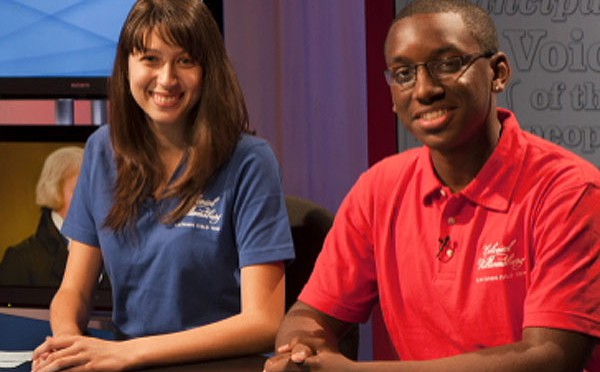Director of Educational Program Development Bill White and his team create a television broadcast to nurture citizens for a new era.
Podcast (audio): Download (1.8MB)
Subscribe: RSS
Transcript
Lloyd Dobyns: Hi, welcome to Past and Present on history.org. This is Behind the Scenes, where you meet the people who work here. That’s my job, I’m Lloyd Dobyns, and mostly I ask questions.
Communicating the conflict, contradiction, adventure and risk of American history to classrooms across the country has been Director of Educational Outreach Bill White’s challenge for eleven years. Bill is with us today to talk about nurturing a new generation of citizenship through the Electronic Field Trip program.
Bill White: We’ve been working on this program now for the last 10 or 15 years actually, and the major reason for doing this is to share the importance of this institution and what we stand for with the rest of the country. American history tells the stories of Americans as they created the republic for themselves and for the next generation. And if our kids don’t understand those stories, then they don’t understand what it means to be an American citizen. They don’t understand what their job as an American citizen should be.
Colonial Williamsburg is a place where that whole story begins, where the founding fathers, that first generation, begin to create the republic that we know today -- the job of citizens that that we know today. It’s absolutely critical that we get that story out around the country to as many kids as we possibly can.
The Electronic Field Trip program is an opportunity for us to take Colonial Williamsburg -- to take American history -- right to the classrooms all around the country. What we do is we send a television signal out of here seven times a year on public television stations and educational channels around the country so that kids can see the museum in real time and talk with us in real time.
The program though is really more than just a television program. The program is also a series of Internet resources. It’s a series of lesson plans for the classroom. It’s using all the best things from living history museums to get kids excited about American history. We don’t just do colonial history. We also are taking stories about the 17th century, or Native Americans before Europeans come here. We’re taking stories about Virginia, but also about New England or farther south. We’re taking stories about the early 19th century, and we every year do a program that is focused on African-American history.
Every Electronic Field Trip comes with teacher materials and help for the teacher. They go all the way from how to use the technology in the classroom to background information on American history. So a teacher finds background essays and timelines and glossaries and already completed lesson plans for their classroom with all the resources that they need to be able to walk in and do that immediately in the classroom.
They also find on the website help in figuring out the technology, because this program comes via television. It also streams across the Internet. There are several different ways that we can actually reach your classroom with these programs. The Electronic Field Trips are correlated to American history standards for every state in the union. It doesn’t matter where you are in the United States, these programs have been correlated to your local American history standards.
And it’s not just American history, quite frankly. These are interdisciplinary programs. So, the Electronic Field Trip also reaches in and involves your kids with literacy standards and the reading instruction that you do in your classroom and reaches out to touch science and mathematics and just about every discipline, particularly the standards that are focused on implementing technology in the classroom.
Every Electronic Field Trip has a slate of online activities for students to do in their classroom that address those those technology standards directly and also provides an interactive element for kids to interact with the past, to actually be participants in the past, to explore history like a historian explores history, to look directly at primary sources and to investigate history in the kind of way that helps to excite kids and make American history relevant to them and to their lives today.
You can use these programs in the classroom as a live event, a special event for the classroom, just like you would take your kids on a field trip to a local museum, bring them on an Electronic Field Trip instead. If you do that, then you have the opportunity to call in and talk with us live. You have the opportunity to create the kind of event and excitement that kids really get excited about and thrive on.
But you can also use these programs any time during the year. All the resources that you need -- the video program, the internet resources, questions and answers -- anything that you need to teach this topic is there and available 365 days a year, 24 hours a day. All you need to do it to log in and access those materials and you can use them any time during the school year.
Well I hope you’ll explore this website: www.history.org/trips. There’s a how to section. Go there and explore it. There’s also an FAQ , make sure that you explore that. There are step-by-step instructions that will help you to figure out the best way to use this program for your kids. I have to tell you that there’s nothing more important than these American history stories for our kids to know. It’s about the job of creating citizens for a new era, American citizens for a new republic, the citizens who can carry this nation forward into the future.

